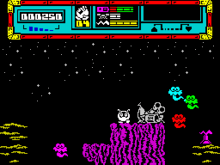Starquake (video game)
 ZX Spectrum Screenshot of Starquake's start screen | |
| Developer(s) | Bubble Bus Software |
|---|---|
| Publisher(s) | Bubble Bus Software |
| Designer(s) | Stephen Crow |
| Programmer(s) | Stephen Crow |
| Platform(s) | Amstrad CPC, Atari 8-bit, Atari ST, BBC Micro, Commodore 64, MS-DOS, MSX, ZX Spectrum, Tatung Einstein |
| Release |
|
| Genre(s) | Arcade adventure |
| Mode(s) | Single-player |
Starquake is an arcade adventure, platform and maze game written by Stephen Crow and published by Bubble Bus Software in 1985. It was released for Commodore 64, MSX, ZX Spectrum, Amstrad CPC, Atari 8-bit family, Tatung Einstein (all 1985), the BBC Micro (1987)[1] and IBM Compatible and Atari ST (both 1988).
Plot
The player controls BLOB (Bio-Logically Operated Being), whose mission is to penetrate the unstable core of a rogue planet which has appeared from a black hole. If the core is not repaired within the set time limit it will implode causing a chain reaction which will destroy the entire universe. The planet is inhabited by various primitive creatures, all hazardous to the touch, and the remnants of a previous civilisation which provides the items needed to rebuild and stabilise the planet core.
Gameplay
Within the game, there are multiple ways to get around;
- Running is the default.
- Hover platforms can be used to fly. Items that BLOB can carry cannot be picked up while on a hover platform.
- BLOB can build his own short-lived platforms to reach high places.
- BLOB can get through some trap like doors by making short-lived platforms then dropping onto them when they will disappear.
- There are some tube shaped lifts which will lift BLOB upwards to the top. BLOB cannot enter these whilst on a hover platform.
- There are also multiple teleport booths scattered around the play area, each with its own destination code.
BLOB is able to carry up to four items at once, using a FIFO arrangement. Some of the items encountered will be useful to repair the core, while others will need to be exchanged using a Cheops Pyramid for something more useful. There is an Access card, which can fill in for any of the numbered chips needed to get through security doors, and for using the aforementioned Pyramid. There is also a Key which can be used to open doors.
As well as items needed to repair the core, the Access card and Key, there are items which will top up BLOB's energy, his platform building capacity or his firepower. There is one cylinder like object which will top up whichever level is lowest, and even add a life if BLOB is down to his last. BLOB can also top up his lives by moving into joysticks which are an extra life.
Points are scored for shooting the various moving hazardous creatures, worth between 80 and 320 points each, and 10,000 points per core item replaced. 250 points are scored for each time BLOB enters a new screen. There are also other hazards, dangerous spikes and energy fields that will kill BLOB on contact, as will the mines that move around like the creatures.
The game features play area of 512 screens. The placement of the objects, and the identities of those needed to fix the core are randomized at the start of the game, the map/screens including locations of teleport booths remain fixed as do their destination codes. There are nine core elements to replace in order to complete the game.
Reception
The ZX Spectrum version was rated number 27 in the Your Sinclair Official Top 100 Games of All Time.[2]. Also, in 2008 this version had got 10th place in Top 25:Spectrum Games of Retro Gamer magazine[3].
References
- ↑ Reeder, Dave (July 1987). "The Arcade: Starquake". A & B Computing. Argus Specialist Publications. p. 55.
Bubble Bus Software, Model B/Master, Disc/tape £11.95/£9.95
- ↑ "Readers' Top 100 Games of All Time". Your Sinclair. September 1993. "Archived copy". Archived from the original on 2012-03-08. Retrieved 2012-02-02.
- ↑ "Top 25:Spectrum Games". Retro Gamer: 87. 2008.
External links
- Starquake at Atari Mania
- Starquake at Lemon 64
- Starquake at SpectrumComputing.co.uk
- Starquake on the Einstein
- ZX Spectrum Starquake instructions
- Map of Starquake